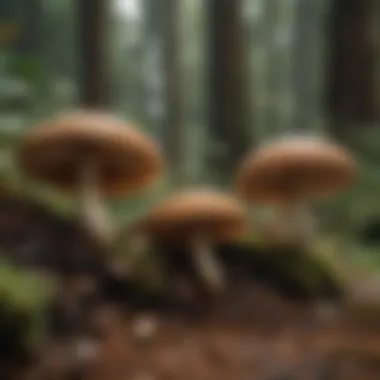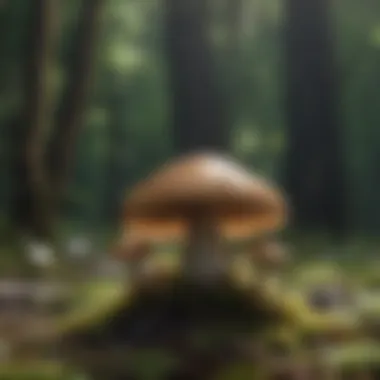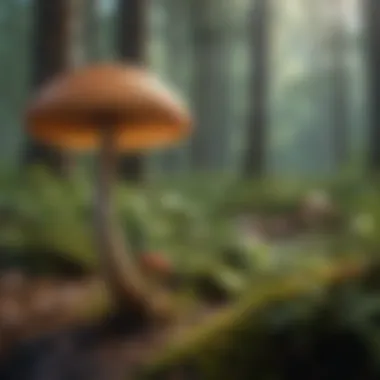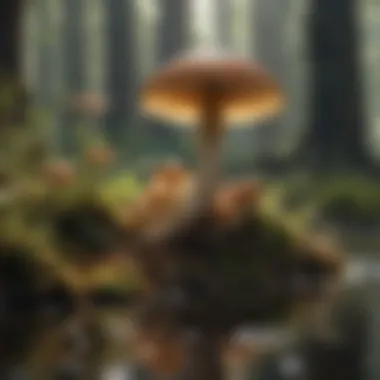Unveiling the Diverse Edible Mushrooms of the Bay Area: A Culinary Exploration


Mushroom Varieties in the Bay Area
As we embark on a journey to unravel the mysteries surrounding edible mushrooms in the Bay Area, it is crucial to understand the diverse array of mushroom varieties that grace this region. From the infamous chanterelles to the delicate oyster mushrooms, each species possesses distinctive characteristics and flavors that elevate the culinary experience to new heights.
Key Mushroom Varieties
Chanterelles
Chanterelles, with their golden hues and meaty texture, are highly coveted among foragers and chefs alike. These mushrooms thrive in the moist woodlands of the Bay Area, adding a subtle earthy flavor to dishes.
Oyster Mushrooms
Delicate oyster mushrooms, found on decaying logs and tree stumps, offer a mild flavor and versatile cooking properties. Their fan-like appearance and soft texture make them a popular choice for various culinary creations.
Morel Mushrooms
Morel mushrooms, with their distinctive honeycomb-like caps, emerge in the spring months, dotting the forest floors of the Bay Area. Highly prized for their nutty and earthy notes, morels hold a special place in the world of gourmet cuisine.
Culinary Uses and Delights
Exploring the culinary realm of these edible treasures unveils a world of possibilities. From sautéing chanterelles with garlic and thyme to grilling oyster mushrooms for a smoky flavor, each variety lends itself to a myriad of cooking techniques. Incorporating mushrooms into soups, stews, risottos, and even grilling them as a standalone dish showcases their versatility and depth of flavor.
Foraging Tips and Safety Precautions
While the allure of foraging for wild mushrooms is enticing, it is imperative to exercise caution and mindfulness during the hunt. Familiarizing oneself with each mushroom's distinct features and growth patterns reduces the risk of misidentification. Consulting with expert mycologists or seasoned foragers can provide valuable insights and ensure a safe foraging experience.
Safety Guidelines
Toxic Lookalikes
Bearing in mind the presence of toxic lookalikes such as the deadly Amanita mushrooms, distinguishing between edible varieties and their harmful counterparts becomes paramount. Understanding the subtle nuances in cap shapes, gill structures, and spore colors aids in accurate identification and mitigates potential risks.
Harvesting Ethics
Respecting the ecosystems that nurture these fungi is integral to sustainable foraging practices. Gathering mushrooms in moderation, refraining from damaging delicate mycelium networks, and leaving no trace of human presence uphold the ecological balance of the natural habitat.
Final Thoughts
Embarking on a quest to explore the realm of edible mushrooms in the Bay Area not only unveils a symphony of flavors and textures but also fosters a deeper connection with the bountiful gifts of nature. By delving into the culinary uses, foraging techniques, and safety measures associated with these mushrooms, enthusiasts can embark on a fulfilling gastronomic and educational journey in the realm of mycology.
Introduction
The world of edible mushrooms in the Bay Area is a treasure trove waiting to be explored. This article serves as a comprehensive guide to understanding the significance and nuances of these fungi. From the forest floors to gourmet dishes, mushrooms play a vital role in our ecosystem and culinary experiences. Through this exploration, readers will uncover the hidden gems of the fungal kingdom and appreciate the diversity and flavors these mushrooms bring to the table.
Overview of Edible Mushrooms


When it comes to foraging for mushrooms, the benefits are manifold. Not only does it provide a connection to nature but it also offers a sustainable way to source fresh and organic ingredients. Foraging for mushrooms can be a meditative experience, allowing individuals to immerse themselves in the natural environment while cultivating mindfulness. Moreover, the nutritional value of wild mushrooms far surpasses their cultivated counterparts, making them a popular choice among food enthusiasts.
Safety is paramount when venturing into the world of foraging. This section delves into the essential precautions one must take while embarking on a mushroom hunting expedition. From identifying toxic varieties to carrying the necessary equipment, these safety measures ensure a secure and enjoyable foraging experience.
Mushroom Varieties in the Bay Area
The Bay Area boasts an array of mushroom varieties waiting to be discovered. Chanterelles, with their delicate funnel shape and apricot-like aroma, are prized for their culinary versatility. Morels, known for their distinctive honeycomb cap, add a nutty flavor to dishes, making them a sought-after ingredient. Porcini, with their robust flavor and meaty texture, are a gourmet delight often used in soups and pastas. Lastly, Lobster Mushrooms, with their vibrant red hue and seafood-like taste, offer a unique twist to mushroom dishes.
Each variety presents its own set of advantages and considerations. Chanterelles, for instance, are prized for their fruity aroma but require precise identification to avoid toxic lookalikes. Morels, on the other hand, are highly coveted for their earthy flavor but demand thorough cooking to neutralize any toxins. Porcini bring a rich umami taste to dishes but must be dried and stored carefully to preserve their flavor, while Lobster Mushrooms offer a striking appearance but necessitate proper cleaning to remove any grit.
This detailed exploration of mushroom varieties in the Bay Area sets the stage for a culinary adventure, with each fungus offering a unique flavor profile and culinary experience.
Identification and Foraging
Importance of Identification and Foraging
Key Features for Identification
Cap Shape and Texture
The cap shape and texture of mushrooms play a crucial role in their identification. Understanding the nuances of each cap variation aids in differentiating between species, guiding foragers towards safe and flavorful picks. The smoothness or roughness of the cap, coupled with its color and size, serves as distinguishing factors. In this article, the emphasis on cap characteristics equips readers with the knowledge necessary to make informed foraging decisions.
Gill and Pore Structure
Examining the gill and pore structure of mushrooms offers significant insights into their classification. The arrangement of gills or pores beneath the cap provides valuable information about spore dispersal and can assist in accurate identification. By elucidating the distinct features of gills and pores, this article enhances readers' awareness of the intricate details crucial for safe foraging practices.
Stem Characteristics
The stem characteristics of mushrooms, including length, texture, color, and base structure, contribute substantially to their overall identification. By describing the unique attributes of stem variations, foragers can refine their selection process and avoid confusion with similar-looking species. Understanding stem characteristics is key to differentiating between edible delicacies and potentially harmful mushrooms, making it a pivotal aspect of foraging in the Bay Area.
Best Practices for Foraging
Locations to Explore
Identifying optimal locations for mushroom foraging is paramount for a successful and fruitful expedition. The microclimates, soil types, and vegetation prevalent in specific areas significantly influence the presence of various mushroom species. By discussing the characteristics of diverse foraging sites in the Bay Area, this article guides enthusiasts towards promising locations rich in mushroom biodiversity.
Tools for Foraging
Utilizing the right tools enhances the efficiency and safety of the foraging process. Essential tools such as a sharp knife, brush, basket, and field guide aid in accurate identification and proper handling of harvested mushrooms. By detailing the significance of each tool and its role in foraging, readers gain a comprehensive understanding of the equipment necessary for a successful mushroom hunting experience.
Ethical Harvesting Guidelines
Adhering to ethical harvesting practices is crucial for preserving mushroom populations and ecosystems. This section emphasizes the importance of sustainable foraging, encouraging foragers to leave no trace, avoid overharvesting, and respect wildlife habitats. By outlining ethical guidelines, this article promotes a responsible approach to mushroom foraging, ensuring the longevity of edible fungi in the Bay Area's natural landscapes.
Culinary Delights
Importance of Culinary Delights


Cooking Techniques
Sautéing
Sautéing mushrooms involves cooking them quickly in a hot pan with a minimal amount of oil or butter. This method allows mushrooms to retain their texture and develop a caramelized exterior, enhancing their natural flavors. It is a preferred technique for many culinary enthusiasts due to its ability to preserve the delicate taste of mushrooms while adding a pleasant crunch.
Roasting
Roasting mushrooms involves baking them at high heat in the oven. This technique intensifies the flavors of mushrooms, creating a rich and robust taste profile. Roasting also adds depth and complexity to the mushrooms, making it a popular choice for enhancing the umami flavors in dishes.
Pickling
Pickling mushrooms involves preserving them in a solution of vinegar, water, and spices. This technique not only extends the shelf life of mushrooms but also infuses them with tangy and zesty flavors. Pickled mushrooms add a unique twist to salads, sandwiches, or charcuterie boards, providing a burst of acidity and contrast in taste.
Recipes Featuring Bay Area Mushrooms
Creamy Chanterelle Pasta
Creamy Chanterelle Pasta showcases the delicate notes of Chanterelle mushrooms in a luscious cream sauce. This dish combines the earthiness of Chanterelles with the richness of pasta, creating a comforting and indulgent meal. The creamy texture complements the meaty Chanterelles, offering a harmonious blend of flavors and textures.
Morel Risotto
Morel Risotto is a classic dish that highlights the nutty and earthy flavors of Morel mushrooms. The creamy consistency of risotto paired with the unique taste of Morels creates a luxurious dining experience. Each bite is filled with the umami essence of Morels, making it a sought-after dish for gourmet enthusiasts.
Porcini Grilled Steak
Porcini Grilled Steak is a decadent recipe that marries the robust flavors of Porcini mushrooms with succulent meat. The earthy profile of Porcini mushrooms enhances the juiciness of the grilled steak, resulting in a savory and unforgettable culinary experience. The umami-packed Porcini mushrooms elevate the steak to new heights, captivating every palate.
Nutritional Benefits
In this section, we delve into the paramount aspect of the nutritional benefits associated with edible mushrooms in the Bay Area. Understanding the nutritional value of these mushrooms is crucial for appreciating the holistic benefits they offer. Mushrooms are a rich source of vitamins, minerals, and other essential nutrients, making them a valuable addition to a balanced diet. By exploring the nutritional benefits in detail, we aim to provide readers with a comprehensive insight into the health implications of incorporating Bay Area mushrooms into their culinary repertoire.
Vitamins and Minerals
Vitamin
The discussion on Vitamin D within the context of Bay Area mushrooms is pivotal to comprehend the unique health contributions this vitamin offers. Vitamin D plays a significant role in maintaining calcium balance in the body and is essential for bone health. The presence of Vitamin D in mushrooms is particularly notable, as it is a rare occurrence in plant-based foods. By consuming mushrooms rich in Vitamin D, individuals can supplement their dietary intake of this crucial vitamin, especially beneficial for vegetarians and individuals with limited sun exposure.
Iron
Iron is another critical mineral found in edible Bay Area mushrooms, contributing to various physiological functions within the body. Iron is indispensable for the formation of hemoglobin, which is responsible for oxygen transport in the blood. Incorporating iron-rich mushrooms into one's diet can aid in preventing anemia and maintaining overall energy levels. The presence of bioavailable iron in mushrooms makes them a valuable source of this essential mineral for individuals seeking to optimize their iron intake.
Selenium
The inclusion of Selenium in discussions of nutritional benefits underscores the diverse array of minerals found in Bay Area mushrooms. Selenium is recognized for its antioxidant properties, playing a vital role in protecting cells from damage caused by free radicals. Mushrooms serve as a notable source of Selenium, offering individuals a natural way to enhance their antioxidant defenses and promote overall health. By elucidating the benefits of Selenium in mushrooms, this section aims to spotlight the multi-faceted nutritional advantages of incorporating these fungi into everyday meals.
Health Benefits


In exploring the health benefits associated with consuming edible mushrooms from the Bay Area, we uncover a tapestry of advantages that extend beyond mere nutrition. Bay Area mushrooms not only provide essential vitamins and minerals but also offer a range of health perks that can promote overall well-being. By delving deep into these health benefits, we aim to empower readers with knowledge that can inspire them to embrace mushrooms as a valuable component of a health-conscious lifestyle.
Boosting Immunity
The immune-boosting properties of Bay Area mushrooms serve as a noteworthy highlight in understanding their role in enhancing overall health. Certain mushrooms contain bioactive compounds that can stimulate the immune system, aiding in defense against infections and diseases. By elucidating the mechanisms through which mushrooms bolster immunity, this section aims to emphasize the proactive role these fungi can play in fortifying the body's natural defenses.
Supporting Digestive Health
The impact of Bay Area mushrooms on digestive health is a crucial aspect that warrants exploration within the realm of health benefits. Mushrooms are rich in dietary fiber and prebiotics, which support gut health by promoting the growth of beneficial gut bacteria. Consuming mushrooms that foster a healthy gut microbiome can contribute to improved digestion, nutrient absorption, and overall gastrointestinal well-being. By shedding light on the digestive benefits of mushrooms, this section endeavors to underscore their role in nurturing a healthy digestive system.
Anti-Inflammatory Properties
The anti-inflammatory properties of Bay Area mushrooms provide a compelling narrative on their potential to mitigate chronic inflammation and associated health conditions. Certain mushrooms contain bioactive compounds that exhibit anti-inflammatory effects, offering a natural means of managing inflammation within the body. By outlining the unique anti-inflammatory properties of Bay Area mushrooms, this section aims to underscore their contribution to holistic health and well-being.
Safety Considerations
Toxic Lookalikes
Death Cap Mushroom
The Death Cap Mushroom, scientifically known as Amanita phalloides, embodies a significant risk in the landscape of mushroom foraging due to its striking resemblance to edible varieties. This deadly fungus harbors a smooth, glossy cap with a pale green hue, often attracting unsuspecting foragers. Its inconspicuous nature juxtaposed with its lethal toxicity makes it a perilous selection for this article's discussion. Individuals must exercise extreme caution and meticulous attention to detail to differentiate the Death Cap Mushroom from safe alternatives, as consumption can lead to severe poisoning and potentially fatal outcomes.
False Morel
Contrary to its name, the False Morel poses a genuine threat in the pursuit of edible mushrooms. With a convoluted cap structure resembling true Morels, this toxic mimic challenges even seasoned foragers. Distinguishing features include a wrinkled cap surface and a lack of true Morel's distinctive pit structure. Despite its visually enticing appearance, the False Morel signifies danger in the world of mushroom foraging, highlighting the necessity for thorough identification prior to consumption. Understanding the nuanced characteristics of the False Morel is vital for enthusiasts seeking to avoid adverse health effects.
Galerina marginata
As an inconspicuous but hazardous mushroom species, Galerina marginata poses a significant risk in the quest for safe foraging practices. With a brownish-orange cap and a slender stem, this deceiving lookalike closely mirrors edible mushrooms, leading to potential misidentification. The key to distinguishing Galerina marginata lies in its ringless stem and gill attachment, characteristics that differentiate it from benign counterparts. Although visually similar to harmless varieties, this toxic lookalike underscores the importance of vigilance when gathering mushrooms in the Bay Area, emphasizing the need for precision in classification and identification.
Proper Cooking and Storage
In tandem with safety considerations, proper cooking and storage techniques play a pivotal role in maximizing the edible potential of foraged mushrooms. Thoroughly cooking mushrooms before consumption is essential to neutralize any potential toxins and enhance flavor profiles. By utilizing appropriate cooking methods and recognizing safe storage practices, enthusiasts can elevate their culinary experiences while ensuring food safety.
Cooking Mushrooms Thoroughly
The practice of cooking mushrooms thoroughly serves as a fundamental step in mitigating risks associated with toxic compounds that may be present in certain varieties. Heat treatment not only eliminates harmful pathogens but also enhances the digestibility of mushrooms, making their consumption a safer and more enjoyable experience. Sautéing, roasting, or simmering mushrooms until they reach an optimal texture ensures that all parts are cooked evenly, minimizing the likelihood of adverse reactions to undercooked fungi. Emphasizing the significance of thorough cooking aligns with the article's overarching theme of promoting responsible foraging practices in the Bay Area.
Refrigeration and Preservation
Effective refrigeration and preservation methods are integral in maintaining the quality and safety of harvested mushrooms. Storing mushrooms in a cool, dry environment helps extend their shelf life and prevents spoilage. Proper air circulation and moisture control aid in preserving the flavor and texture of mushrooms, ensuring they retain their culinary value over an extended period. By adopting suitable preservation techniques such as drying or pickling, enthusiasts can savor the flavors of Bay Area mushrooms beyond their peak season, enabling year-round enjoyment of these delectable fungi.
Conclusion
Final Thoughts
Appreciating the Diversity of Edible Mushrooms
Appreciating the Diversity of Edible Mushrooms holds immense significance within the context of this article, highlighting the unique range of flavors and nutritional profiles that mushrooms offer. This section fosters a deeper understanding of the intricate interplay between different mushroom varieties, from the earthy tones of porcini to the delicate fragrance of chanterelles. By appreciating this diversity, readers can elevate their culinary experiences and develop a newfound respect for the complexities of nature's provisions. The unparalleled richness of flavors presented by these edible mushrooms serves as a testament to the wondrous tapestry of tastes waiting to be explored in the Bay Area.
Continued Exploration of Fungi in the Bay Area
The Continued Exploration of Fungi in the Bay Area encapsulates the never-ending journey of discovery and learning that unfolds when engaging with mushrooms. This section encourages enthusiasts to delve deeper into the realms of mycology, fostering a sense of curiosity and reverence for the fascinating world of fungi. By venturing further into the wilderness and uncovering hidden gems within the fungal kingdom, individuals can enrich their knowledge and appreciation for the intricate connections that sustain these organisms. The ongoing exploration of fungi in the Bay Area not only offers endless opportunities for new encounters but also underscores the importance of conservation efforts to preserve these valuable resources for future generations.







